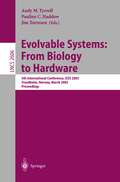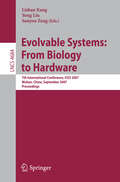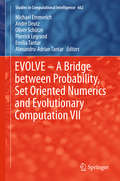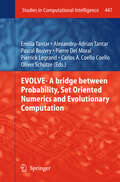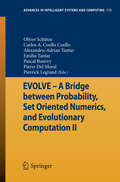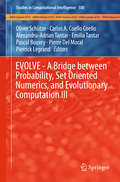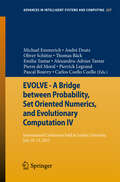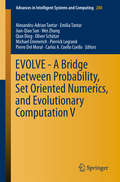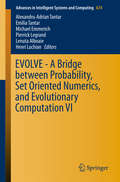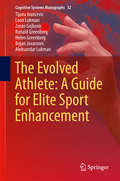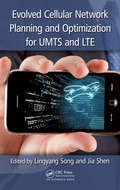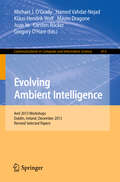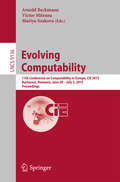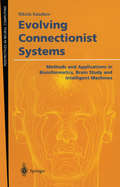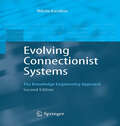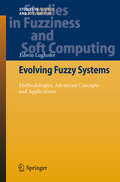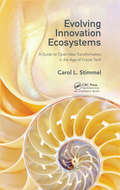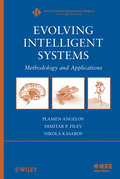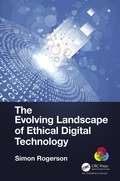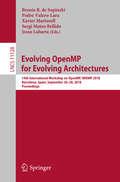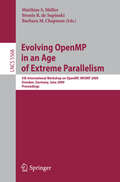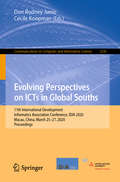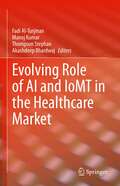- Table View
- List View
Evolvable Systems: 5th International Conference, ICES 2003, Trondheim, Norway, March 17-20, 2003, Proceedings (Lecture Notes in Computer Science #2606)
by Andy M. Tyrrell Pauline C. Haddow Jim TorresenThe idea of evolving machines, whose origins can be traced to the cybernetics movementofthe1940sand1950s,hasrecentlyresurgedintheformofthenascent ?eld of bio-inspired systems and evolvable hardware. The inaugural workshop, Towards Evolvable Hardware, took place in Lausanne in October 1995, followed by the First International Conference on Evolvable Systems: From Biology to Hardware (ICES), held in Tsukuba, Japan in October 1996. The second ICES conference was held in Lausanne in September 1998, with the third and fourth being held in Edinburgh, April 2000 and Tokyo, October 2001 respectively. This has become the leading conference in the ?eld of evolvable systems and the 2003 conference promised to be at least as good as, if not better than, the four that preceeded it. The ?fth international conference was built on the success of its predec- sors, aiming at presenting the latest developments in the ?eld. In addition, it brought together researchers who use biologically inspired concepts to imp- ment real systems in arti?cial intelligence, arti?cial life, robotics, VLSI design and related domains. We would say that this ?fth conference followed on from the previous four in that it consisted of a number of high-quality interesting thought-provoking papers.
Evolvable Systems: 7th International Conference, ICES 2007, Wuhan, China, September 21-23, 2007, Proceedings (Lecture Notes in Computer Science #4684)
by Sanyou ZengThis book constitutes the refereed proceedings of the 7th International Conference on Evolvable Systems, ICES 2007, held in Wuhan, China, in September 2007. The 41 revised full papers collected in this volume are organized in topical sections on digital hardware evolution, analog hardware evolution, bio-inspired systems, mechanical hardware evolution, evolutionary design, evolutionary algorithms in hardware design, and hardware implementation of evolutionary algorithms.
EVOLVE – A Bridge between Probability, Set Oriented Numerics and Evolutionary Computation VII (Studies in Computational Intelligence #662)
by Michael Emmerich André Deutz Oliver Schütze Pierrick Legrand Emilia Tantar Alexandru-Adrian TantarThis book comprises nine selected works on numerical and computational methods for solving multiobjective optimization, game theory, and machine learning problems. It provides extended versions of selected papers from various fields of science such as computer science, mathematics and engineering that were presented at EVOLVE 2013 held in July 2013 at Leiden University in the Netherlands. The internationally peer-reviewed papers include original work on important topics in both theory and applications, such as the role of diversity in optimization, statistical approaches to combinatorial optimization, computational game theory, and cell mapping techniques for numerical landscape exploration. Applications focus on aspects including robustness, handling multiple objectives, and complex search spaces in engineering design and computational biology.
EVOLVE- A Bridge between Probability, Set Oriented Numerics and Evolutionary Computation (Studies in Computational Intelligence #447)
by Emilia Tantar Oliver Schütze Alexandru-Adrian Tantar Pascal Bouvry Pierre Del Moral Pierrick Legrand Carlos A. Coello CoelloThe aim of this book is to provide a strong theoretical support for understanding and analyzing the behavior of evolutionary algorithms, as well as for creating a bridge between probability, set-oriented numerics and evolutionary computation. The volume encloses a collection of contributions that were presented at the EVOLVE 2011 international workshop, held in Luxembourg, May 25-27, 2011, coming from invited speakers and also from selected regular submissions. The aim of EVOLVE is to unify the perspectives offered by probability, set oriented numerics and evolutionary computation. EVOLVE focuses on challenging aspects that arise at the passage from theory to new paradigms and practice, elaborating on the foundations of evolutionary algorithms and theory-inspired methods merged with cutting-edge techniques that ensure performance guarantee factors. EVOLVE is also intended to foster a growing interest for robust and efficient methods with a sound theoretical background.The chapters enclose challenging theoretical findings, concrete optimization problems as well as new perspectives. By gathering contributions from researchers with different backgrounds, the book is expected to set the basis for a unified view and vocabulary where theoretical advancements may echo in different domains.
EVOLVE - A Bridge between Probability, Set Oriented Numerics, and Evolutionary Computation II (Advances in Intelligent Systems and Computing #175)
by Oliver Schütze Carlos A. Coello Coello Alexandru-Adrian Tantar Emilia Tantar Pascal Bouvry Pierre Del Moral Pierrick LegrandThis book comprises a selection of papers from the EVOLVE 2012 held in Mexico City, Mexico. The aim of the EVOLVE is to build a bridge between probability, set oriented numerics and evolutionary computing, as to identify new common and challenging research aspects. The conference is also intended to foster a growing interest for robust and efficient methods with a sound theoretical background. EVOLVE is intended to unify theory-inspired methods and cutting-edge techniques ensuring performance guarantee factors. By gathering researchers with different backgrounds, a unified view and vocabulary can emerge where the theoretical advancements may echo in different domains. Summarizing, the EVOLVE focuses on challenging aspects arising at the passage from theory to new paradigms and aims to provide a unified view while raising questions related to reliability, performance guarantees and modeling. The papers of the EVOLVE 2012 make a contribution to this goal.
EVOLVE - A Bridge between Probability, Set Oriented Numerics, and Evolutionary Computation III (Studies in Computational Intelligence #500)
by Oliver Schuetze Carlos A. Coello Coello Alexandru-Adrian Tantar Emilia Tantar Pascal Bouvry Pierre Del Moral Pierrick LegrandThis book comprises a selection of extended abstracts and papers presented at the EVOLVE 2012 held in Mexico City, Mexico. The aim of the EVOLVE is to build a bridge between probability, set oriented numerics, and evolutionary computation as to identify new common and challenging research aspects. The conference is also intended to foster a growing interest for robust and efficient methods with a sound theoretical background. EVOLVE aims to unify theory-inspired methods and cutting-edge techniques ensuring performance guarantee factors. By gathering researchers with different backgrounds, a unified view and vocabulary can emerge where the theoretical advancements may echo in different domains. Summarizing, the EVOLVE conference focuses on challenging aspects arising at the passage from theory to new paradigms and aims to provide a unified view while raising questions related to reliability, performance guarantees, and modeling. The extended papers of the EVOLVE 2012 make a contribution to this goal.
EVOLVE - A Bridge between Probability, Set Oriented Numerics, and Evolutionary Computation IV: International Conference Held at Leiden University, July 10-13, 2013 (Advances in Intelligent Systems and Computing #227)
by Michael Emmerich Andre Deutz Oliver Schuetze Thomas Bäck Emilia Tantar Alexandru-Adrian Tantar Del Moral. P Pierrick Legrand Pascal Bouvry Carlos A. CoelloNumerical and computational methods are nowadays used in a wide range of contexts in complex systems research, biology, physics, and engineering. Over the last decades different methodological schools have emerged with emphasis on different aspects of computation, such as nature-inspired algorithms, set oriented numerics, probabilistic systems and Monte Carlo methods. Due to the use of different terminologies and emphasis on different aspects of algorithmic performance there is a strong need for a more integrated view and opportunities for cross-fertilization across particular disciplines. These proceedings feature 20 original publications from distinguished authors in the cross-section of computational sciences, such as machine learning algorithms and probabilistic models, complex networks and fitness landscape analysis, set oriented numerics and cell mapping, evolutionary multiobjective optimization, diversity-oriented search, and the foundations of genetic programming algorithms. By presenting cutting edge results with a strong focus on foundations and integration aspects this work presents a stepping stone towards efficient, reliable, and well-analyzed methods for complex systems management and analysis.
EVOLVE - A Bridge between Probability, Set Oriented Numerics, and Evolutionary Computation V (Advances in Intelligent Systems and Computing #288)
by Alexandru-Adrian Tantar Carlos A. Coello Coello Emilia Tantar Jian-Qiao Sun Wei Zhang Qian Ding Oliver Schütze Michael Emmerich Pierrick Legrand Pierre Del MoralThis volume encloses research articles that were presented at the EVOLVE 2014 International Conference in Beijing, China, July 1–4, 2014. The book gathers contributions that emerged from the conference tracks, ranging from probability to set oriented numerics and evolutionary computation; all complemented by the bridging purpose of the conference, e.g. Complex Networks and Landscape Analysis, or by the more application oriented perspective. The novelty of the volume, when considering the EVOLVE series, comes from targeting also the practitioner’s view. This is supported by the Machine Learning Applied to Networks and Practical Aspects of Evolutionary Algorithms tracks, providing surveys on new application areas, as in the networking area and useful insights in the development of evolutionary techniques, from a practitioner’s perspective. Complementary to these directions, the conference tracks supporting the volume, follow on the individual advancements of the subareas constituting the scope of the conference, through the Computational Game Theory, Local Search and Optimization, Genetic Programming, Evolutionary Multi-objective optimization tracks.
EVOLVE - A Bridge between Probability, Set Oriented Numerics, and Evolutionary Computation VI (Advances in Intelligent Systems and Computing #674)
by Alexandru-Adrian Tantar Emilia Tantar Michael Emmerich Pierrick Legrand Lenuta Alboaie Henri LuchianThis book comprises selected research papers from the 2015 edition of the EVOLVE conference, which was held on June 18–June 24, 2015 in Iași, Romania. It presents the latest research on Probability, Set Oriented Numerics, and Evolutionary Computation. The aim of the EVOLVE conference was to provide a bridge between probability, set oriented numerics and evolutionary computation and to bring together experts from these disciplines. The broad focus of the EVOLVE conference made it possible to discuss the connection between these related fields of study computational science. The selected papers published in the proceedings book were peer reviewed by an international committee of reviewers (at least three reviews per paper) and were revised and enhanced by the authors after the conference. The contributions are categorized into five major parts, which are:Multicriteria and Set-Oriented Optimization; Evolution in ICT Security; Computational Game Theory; Theory on Evolutionary Computation; Applications of Evolutionary Algorithms.The 2015 edition shows a major progress in the aim to bring disciplines together and the research on a number of topics that have been discussed in previous editions of the conference matured over time and methods have found their ways in applications. In this sense the book can be considered an important milestone in bridging and thereby advancing state-of-the-art computational methods.
The Evolved Athlete: A Guide for Elite Sport Enhancement (Cognitive Systems Monographs #32)
by Tijana Ivancevic Leon Lukman Zoran Gojkovic Ronald Greenberg Helen Greenberg Bojan Jovanovic Aleksandar LukmanThis handbook provides insights into becoming a better and more evolved athlete. It offers aspiring athletes, regardless of skill level, a better understanding of their bodies and how to unlock the unlimited potential of muscles without injury. It focuses on the “superhero” muscle: the iliopsoas, and also sheds light on Diamond-Corporation’s new technology and elite athleticism, and how these can contribute to a healthier life. Lastly, the authors explore the mindset of success and provide exercises for remaining calm under pressure. This stand-alone book is the sequel to Paradigm Shift for Future Tennis and Enhancing Performance and Reducing Stress in Sport (2014, Springer).This book is written by scientists, whose expertise collectively spans the fields of biomechanics, clinical surgery, current and former elite athleticism, engineering and naturopath doctoral work. Together, they aim to inspire and educate athletes on how to improve their sports performance by using new technologies, world class biomechanics knowledge and ancient herbal medicines.
Evolved Cellular Network Planning and Optimization for UMTS and LTE
by Lingyang Song Jia ShenMost books on network planning and optimization provide limited coverage of either GSM or WCDMA techniques. Few scrape the surface of HSPA, and even fewer deal with TD-SCDMA. Filling this void, Evolved Cellular Network Planning and Optimization for UMTS and LTE presents an accessible introduction to all stages of planning and optimizing UMTS, HSPA,
Evolving Ambient Intelligence: AmI 2013 Workshops, Dublin, Ireland, December 3-5, 2013. Revised Selected Papers (Communications in Computer and Information Science #413)
by Michael O'Grady Hamed Vahdat-Nejad Klaus-Hendrik Wolf Mauro Dragone Juan Ye Carsten Röcker Gregory O'HareThis book constitutes the refereed proceedings of the workshops co-located with the 4th International Joint Conference on Ambient Intelligence, AmI 2013, held in Dublin, Ireland, in December 2013. The 33 revised full papers presented were carefully reviewed and selected from numerous submissions to the following workshops: 5th International Workshop on Intelligent Environments Supporting Healthcare and Well-being (WISHWell’13) 3d International workshop on Pervasive and Context-Aware Middleware (PerCAM’13), 2nd International Workshop on Adaptive Robotic Ecologies (ARE'13), International Workshop on Aesthetic Intelligence (AxI'13), First International Workshop on Uncertainty in Ambient Intelligence (UAmI13). The papers are organized in topical sections on intelligent environments supporting healthcare and well-being; adaptive robotic ecologies; uncertainty in ambient intelligence; aesthetic intelligence; pervasive and context-aware middleware.
Evolving Computability: 11th Conference on Computability in Europe, CiE 2015, Bucharest, Romania, June 29-July 3, 2015. Proceedings (Lecture Notes in Computer Science #9136)
by Arnold Beckmann Victor Mitrana Mariya SoskovaThis book constitutes the refereed proceedings of the 11th Conference on Computability in Europe, CiE 2015, held in Bucharest, Romania, in June/July 2015.The 26 revised papers presented were carefully reviewed and selected from 64 submissions and included together with 10 invited papers in this proceedings. The conference CiE 2015 has six special sessions: two sessions, Representing Streams and Reverse Mathematics, were introduced for the first time in the conference series. In addition to this, new developments in areas frequently covered in the CiE conference series were addressed in the further special sessions on Automata, Logic and Infinite Games; Bio-inspired Computation; Classical Computability Theory; as well as History and Philosophy of Computing.
Evolving Connectionist Systems: Methods and Applications in Bioinformatics, Brain Study and Intelligent Machines (Perspectives in Neural Computing)
by Nikola KasabovMany methods and models have been proposed for solving difficult problems such as prediction, planning and knowledge discovery in application areas such as bioinformatics, speech and image analysis. Most, however, are designed to deal with static processes which will not change over time. Some processes - such as speech, biological information and brain signals - are not static, however, and in these cases different models need to be used which can trace, and adapt to, the changes in the processes in an incremental, on-line mode, and often in real time. This book presents generic computational models and techniques that can be used for the development of evolving, adaptive modelling systems. The models and techniques used are connectionist-based (as the evolving brain is a highly suitable paradigm) and, where possible, existing connectionist models have been used and extended. The first part of the book covers methods and techniques, and the second focuses on applications in bioinformatics, brain study, speech, image, and multimodal systems. It also includes an extensive bibliography and an extended glossary. Evolving Connectionist Systems is aimed at anyone who is interested in developing adaptive models and systems to solve challenging real world problems in computing science or engineering. It will also be of interest to researchers and students in life sciences who are interested in finding out how information science and intelligent information processing methods can be applied to their domains.
Evolving Connectionist Systems: The Knowledge Engineering Approach
by Nikola K. KasabovThis second edition of the must-read work in the field presents generic computational models and techniques that can be used for the development of evolving, adaptive modeling systems, as well as new trends including computational neuro-genetic modeling and quantum information processing related to evolving systems. New applications, such as autonomous robots, adaptive artificial life systems and adaptive decision support systems are also covered.
Evolving Fuzzy Systems - Methodologies, Advanced Concepts and Applications (Studies in Fuzziness and Soft Computing #266)
by Edwin LughoferIn today’s real-world applications, there is an increasing demand of integrating new information and knowledge on-demand into model building processes to account for changing system dynamics, new operating conditions, varying human behaviors or environmental influences.Evolving fuzzy systems (EFS) are a powerful tool to cope with this requirement, as they are able to automatically adapt parameters, expand their structure and extend their memory on-the-fly, allowing on-line/real-time modeling. This book comprises several evolving fuzzy systems approaches which have emerged during the last decade and highlights the most important incremental learning methods used. The second part is dedicated to advanced concepts for increasing performance, robustness, process-safety and reliability, for enhancing user-friendliness and enlarging the field of applicability of EFS and for improving the interpretability and understandability of the evolved models. The third part underlines the usefulness and necessity of evolving fuzzy systems in several online real-world application scenarios, provides an outline of potential future applications and raises open problems and new challenges for the next generation evolving systems, including human-inspired evolving machines. The book includes basic principles, concepts, algorithms and theoretic results underlined by illustrations. It is dedicated to researchers from the field of fuzzy systems, machine learning, data mining and system identification as well as engineers and technicians who apply data-driven modeling techniques in real-world systems.
Evolving Innovation Ecosystems: A Guide to Open Idea Transformation in the Age of Future Tech
by Carol L. StimmelWhile emerging technologies create massive opportunity, especially for investors and companies that seek more adaptable forms of economic growth than currently available, value is held inert by traditional approaches, patents, and other closed systems. Yet, open data, content, and information may be the key to mass innovation for future technologies, although they bring difficult challenges to private-industry models that depend on the established ideas of intellectual property. It is from this foundational observation that OpenXFORM (a blending of the words Open and the engineering abbreviation for Transformation) was developed and is explored and described in this book. The intent of the model design is to synthesize an approach to the process of innovation, inspired by natural systems and human-centric design processes. OpenXFORM describes how an open system of innovation can adapt to the unregulated world of information, data, and content; can decompose its own information to release to the open world; and can discover ways to find the points of synergy among the studied and tested methodologies that put human relationships first. This book presents an explicit innovation process that shows how to move from a breakthrough idea through a process that encourages innovative thinkers to test their assumptions, validate hypotheses, and tune and tweak their ideas, not only to drive solutions for users but also to meet the strategic goals of their companies. The anatomy of innovation through OpenXFORM contains the process for moving ideas from a flight of fancy to an explicit concept that is ready to produce.
Evolving Innovation Ecosystems: A Guide to Open Idea Transformation in the Age of Future Tech
by Carol L. StimmelWhile emerging technologies create massive opportunity, especially for investors and companies that seek more adaptable forms of economic growth than currently available, value is held inert by traditional approaches, patents, and other closed systems. Yet, open data, content, and information may be the key to mass innovation for future technologies, although they bring difficult challenges to private-industry models that depend on the established ideas of intellectual property. It is from this foundational observation that OpenXFORM (a blending of the words Open and the engineering abbreviation for Transformation) was developed and is explored and described in this book. The intent of the model design is to synthesize an approach to the process of innovation, inspired by natural systems and human-centric design processes. OpenXFORM describes how an open system of innovation can adapt to the unregulated world of information, data, and content; can decompose its own information to release to the open world; and can discover ways to find the points of synergy among the studied and tested methodologies that put human relationships first. This book presents an explicit innovation process that shows how to move from a breakthrough idea through a process that encourages innovative thinkers to test their assumptions, validate hypotheses, and tune and tweak their ideas, not only to drive solutions for users but also to meet the strategic goals of their companies. The anatomy of innovation through OpenXFORM contains the process for moving ideas from a flight of fancy to an explicit concept that is ready to produce.
Evolving Intelligent Systems: Methodology and Applications (IEEE Press Series on Computational Intelligence #12)
by Plamen Angelov Dimitar P. Filev Nik KasabovFrom theory to techniques, the first all-in-one resource for EIS There is a clear demand in advanced process industries, defense, and Internet and communication (VoIP) applications for intelligent yet adaptive/evolving systems. Evolving Intelligent Systems is the first self- contained volume that covers this newly established concept in its entirety, from a systematic methodology to case studies to industrial applications. Featuring chapters written by leading world experts, it addresses the progress, trends, and major achievements in this emerging research field, with a strong emphasis on the balance between novel theoretical results and solutions and practical real-life applications. Explains the following fundamental approaches for developing evolving intelligent systems (EIS): the Hierarchical Prioritized Structure the Participatory Learning Paradigm the Evolving Takagi-Sugeno fuzzy systems (eTS+) the evolving clustering algorithm that stems from the well-known Gustafson-Kessel offline clustering algorithm Emphasizes the importance and increased interest in online processing of data streams Outlines the general strategy of using the fuzzy dynamic clustering as a foundation for evolvable information granulation Presents a methodology for developing robust and interpretable evolving fuzzy rule-based systems Introduces an integrated approach to incremental (real-time) feature extraction and classification Proposes a study on the stability of evolving neuro-fuzzy recurrent networks Details methodologies for evolving clustering and classification Reveals different applications of EIS to address real problems in areas of: evolving inferential sensors in chemical and petrochemical industry learning and recognition in robotics Features downloadable software resources Evolving Intelligent Systems is the one-stop reference guide for both theoretical and practical issues for computer scientists, engineers, researchers, applied mathematicians, machine learning and data mining experts, graduate students, and professionals.
The Evolving Landscape of Ethical Digital Technology
by Simon RogersonIn a world that is awash in ubiquitous technology, even the least tech-savvy know that we must take care how that technology affects individuals and society. That governments and organizations around the world now focus on these issues, that universities and research institutes in many different languages dedicate significant resources to study the issues, and that international professional organizations have adopted standards and directed resources toward ethical issues in technology is in no small part the result of the work of Simon Rogerson. – Chuck Huff, Professor of Social Psychology at Saint Olaf College, Northfield, Minnesota In 1995, Apple launched its first WWW server, Quick Time On-line. It was the year Microsoft released Internet Explorer and sold 7 million copies of Windows 95 in just 2 months. In March 1995, the author Simon Rogerson opened the first ETHICOMP conference with these words: We live in a turbulent society where there is social, political, economic and technological turbulence … it is causing a vast amount of restructuring within all these organisations which impacts on individuals, which impacts on the way departments are set up, organisational hierarchies, job content, span of control, social interaction and so on and so forth. … Information is very much the fuel of modern technological change. Almost anything now can be represented by the technology and transported to somewhere else. It's a situation where the more information a computer can process, the more of the world it can actually turn into information. That may well be very exciting, but it is also very concerning. That could be describing today. More than 25 years later, these issues are still at the forefront of how ethical digital technology can be developed and utilised. This book is an anthology of the author’s work over the past of 25 years of pioneering research in digital ethics. It is structured into five themes: Journey, Process, Product, Future and Education. Each theme commences with an introductory explanation of the papers, their relevance and their interrelationship. The anthology finishes with a concluding chapter which summarises the key messages and suggests what might happen in the future. Included in this chapter are insights from some younger leading academics who are part of the community charged with ensuring that ethical digital technology is realised.
The Evolving Landscape of Ethical Digital Technology
by Simon RogersonIn a world that is awash in ubiquitous technology, even the least tech-savvy know that we must take care how that technology affects individuals and society. That governments and organizations around the world now focus on these issues, that universities and research institutes in many different languages dedicate significant resources to study the issues, and that international professional organizations have adopted standards and directed resources toward ethical issues in technology is in no small part the result of the work of Simon Rogerson. – Chuck Huff, Professor of Social Psychology at Saint Olaf College, Northfield, Minnesota In 1995, Apple launched its first WWW server, Quick Time On-line. It was the year Microsoft released Internet Explorer and sold 7 million copies of Windows 95 in just 2 months. In March 1995, the author Simon Rogerson opened the first ETHICOMP conference with these words: We live in a turbulent society where there is social, political, economic and technological turbulence … it is causing a vast amount of restructuring within all these organisations which impacts on individuals, which impacts on the way departments are set up, organisational hierarchies, job content, span of control, social interaction and so on and so forth. … Information is very much the fuel of modern technological change. Almost anything now can be represented by the technology and transported to somewhere else. It's a situation where the more information a computer can process, the more of the world it can actually turn into information. That may well be very exciting, but it is also very concerning. That could be describing today. More than 25 years later, these issues are still at the forefront of how ethical digital technology can be developed and utilised. This book is an anthology of the author’s work over the past of 25 years of pioneering research in digital ethics. It is structured into five themes: Journey, Process, Product, Future and Education. Each theme commences with an introductory explanation of the papers, their relevance and their interrelationship. The anthology finishes with a concluding chapter which summarises the key messages and suggests what might happen in the future. Included in this chapter are insights from some younger leading academics who are part of the community charged with ensuring that ethical digital technology is realised.
Evolving OpenMP for Evolving Architectures: 14th International Workshop on OpenMP, IWOMP 2018, Barcelona, Spain, September 26–28, 2018, Proceedings (Lecture Notes in Computer Science #11128)
by Bronis R. de Supinski Pedro Valero-Lara Xavier Martorell Sergi Mateo Bellido Jesus LabartaThis book constitutes the proceedings of the 14th International Workshop on Open MP, IWOMP 2018, held in Barcelona, Spain, in September 2018.The 16 full papers presented in this volume were carefully reviewed and selected for inclusion in this book. The papers are organized in topical sections named: best paper; loops and OpenMP; OpenMP in heterogeneous systems; OpenMP improvements and innovations; OpenMP user experiences: applications and tools; and tasking evaluations.
Evolving OpenMP in an Age of Extreme Parallelism: 5th International Workshop on OpenMP, IWOMP 2009, Dresden, Germany, June 3-5, 2009 Proceedings (Lecture Notes in Computer Science #5568)
by Matthias S. Müller Bronis R. De Supinski Barbara ChapmanEvolving Perspectives on ICTs in Global Souths: 11th International Development Informatics Association Conference, IDIA 2020, Macau, China, March 25–27, 2020, Proceedings (Communications in Computer and Information Science #1236)
by Don Rodney Junio Cecile KoopmanThis book constitutes the refereed proceedings of the 11th International Development Informatics Association Conference, IDIA 2020, held in Macau, China, in March 2020.*The 14 revised full papers presented were carefully reviewed and selected from 43 submissions. The papers are organized in topical sections on ICT4D: taking stock; harnessing frontier technologies for sustainable development; ICT4D discourse, methodologies, and theoretical reflections; the evolving Global Souths.*The conference was held virtually due to the COVID-19 pandemic.
Evolving Role of AI and IoMT in the Healthcare Market
by Manoj Kumar Fadi Al-Turjman Akashdeep Bhardwaj Thompson StephanThis book is a proficient guide to understanding artificial intelligence (IoT) and the Internet of Medical Things (IoMT) in healthcare. The book provides a comprehensive study on the applications of AI and IoT in various medical domains. The book shows how the implementation of innovative solutions in healthcare is beneficial, and IoT, together with AI, are strong drivers of the digital transformation regardless of what field the technologies are applied in. Therefore, this book provides a high level of understanding with the emerging technologies on the Internet of Things, wearable devices, and AI in IoMT, which offers the potential to acquire and process a tremendous amount of data from the physical world.
